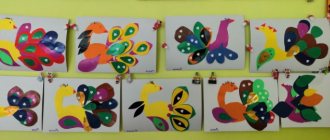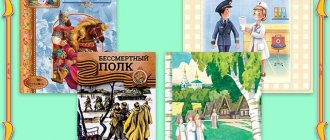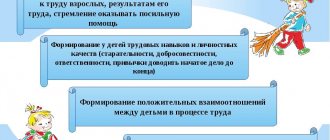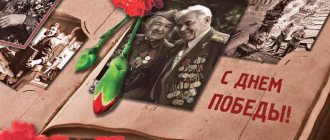Education of preschool children based on the traditions of the Russian people
Petrushkina Svetlana Anatolyevna Bondareva Elena Vasilievna Makeeva Marina Sergeevna educators MBDOU DS No. 22 “Smile” Starooskolsky urban district
EDUCATION OF PRESCHOOL CHILDREN BASED ON THE TRADITIONS OF THE RUSSIAN PEOPLE
Preschool childhood is the beginning of life, when the prerequisites for the high human principles of personality are laid. Patriotic feelings are formed in the process of life and existence of a person located within a specific sociocultural environment. Patriotism is both devotion to one’s Fatherland and the desire to do everything possible to preserve the cultural identity of each people that is part of Russia. Modern children know little about their hometown, country, the peculiarities of folk traditions, are often indifferent to close people, including group mates, and rarely sympathize with the grief of others. Working with parents on the issue of moral and patriotic education in the family is clearly insufficient. Today, considering the heritage of the past, we do not always understand the meaning of folk holidays, ancient traditions that reflected important aspects of the life of the people. Of course, not all traditions have survived to this day; many of them have been completely lost. But those that have survived make it possible to find out how people lived in the old days, how they worked and rested, and what they dreamed about. Only a careful attitude towards the heritage of our ancestors will help preserve the historical memory of generations, not lose touch with the roots of our people, and cultivate national pride.
Times change, but man’s desire for goodness, light, love and beauty remains eternal. The work of educating preschoolers according to the traditions of the Russian people passes through all types of children’s activities. Using folklore and the works of Russian writers and poets in the development of children's speech, we must reveal the spiritual and moral potential of the work and help the child understand its meaning. The educational value of folk tales has been highly valued by teachers at all times, since fairy tales carry goodness, teach friendship, mutual support, hard work, and expose human vices in an unattractive way. Therefore, the teacher uses works of oral folk art in instilling moral qualities in children. Visual activities introduce the history and characteristics of folk crafts. Children enjoy sculpting with clay and then painting Dymkovo toys and Gzhel dishes. This is a labor-intensive process that requires children to persevere, be patient, and be able to finish what they have started. The children learn to respect work and take care of its results. In addition, the teacher introduces children to paintings by Russian artists who glorify the beauty of Russian nature, while the children express their opinion about the painting, why they liked it, and what the child saw special about it. All this contributes to the development of moral feelings in children and love for the Motherland.
Pays great attention to oral folk art. With bated breath, children listen to the reading of Russian folk tales. Fairy tale heroes come to life before their eyes on the flannelgraph and in the puppet theater. They begin their dialogue with young viewers, and it seems that children sincerely believe in live communication with them. They remember their good deeds and draw conclusions for themselves. Honest, brave, kind, hardworking, brave and fair heroes of fairy tales contribute to the manifestation of the same beautiful and positive actions and qualities in our children. The children enjoy learning folk songs and performing round dances. Children happily sing songs to their dolls while playing and love to listen to them before bed during quiet time. All this forms in the child the richness, melody, beauty and melodiousness of his native Russian language. Antique household items help children from a very early age understand that they are part of the great Russian people.
Advertising message
With the help of parents, they conduct conversations with children over a Russian samovar, trying to introduce them to an old Russian hut with national household items, such as: a Russian stove, a table, benches around the table, wooden dishes, embroidered towels. The group successfully celebrates the holidays “Carol has come - open the gates”, “Maslenitsa”. The children happily learned carols and prepared costumes. With their carols, they congratulated the children from other groups, the kindergarten administration, and visited the medical workers and kitchen workers. The holiday, of course, ended with tea drinking over a Russian samovar and folk games. The holiday “Dear Maslenitsa – our annual guest” was no less interesting. The children happily read poems about Maslenitsa and enjoyed pancakes. Beautiful poems and songs about Maslenitsa, games and round dances, proverbs and sayings and of course pancakes have become permanent attributes of Maslenitsa week. The children's productive activity was an application to transform a pancake into a symbol of the red sun. All this becomes a prerequisite for the formation of a sustainable interest in folk art, a better understanding by children of its necessity and value, respect for the work and talent of Russian masters. Carrying out such work requires the active participation of all children, even the most passive and shy.
Thus, in addition to cognitive, speech, artistic, aesthetic, moral and emotional development, this kind of event also contributes to the social development of children.
We also believe that love for the Motherland and the traditions of the Russian people, for one’s native land should be cultivated on the basis of love for nature, therefore we conduct activities with children that help children fall in love with nature, see its beauty, and take care of its preservation. These include excursions, quizzes, studying the folk seasonal calendar, and working in nature. During walks we use folk games, with the help of which the problems of children’s physical development are solved. But folk games also help solve moral problems: they teach children to communicate, help each other, and foster a sense of camaraderie.
In conclusion, I would like to note an important feature that also connects a child from the first years of life - this is the language of his people, which the child learns through folk songs, music, games, folk toys, impressions of the nature of his native land, the life and customs of people. Through a native song, fairy tale, game, oral and verbal creativity, mastering the native language, the child receives the first ideas about the culture of his people.
Bibliography:
- Knyazeva O.L., Makhaneva M.D. Introducing children to the origins of Russian folk culture. Educational and methodological manual. – St. Petersburg: Childhood – Press, 2010
- Kokueva L.V. Spiritual and moral education of preschool children based on the cultural traditions of their people. M.: ARKTI, 2005.
- Borovkova E. B., Volina N.I., Efimov M.K. Formation of moral health of preschool children. Activities, games, exercises. – M.: Sfera shopping center, 2003.
- Zvereva O.L., Krotova T.V. Parent meetings at preschool educational institutions.
What are folk traditions and customs?
Many families have their own traditions and customs. In one, for example, they always drink tea with lemon in the morning, and hot cocoa in the evening. And so every day. Another family may have different customs. For example, give each other handmade cards for the holidays.
Traditions and customs are characteristic not only of individual families, but also of entire nations. Some of them may seem stupid and funny, others - understandable and wise. The Slavic peoples have a very good tradition of giving up their seats in transport to the elderly. This seems normal to all of us. But the French do not do this.
EASTER CHRISTIAN
Easter celebrates the resurrection of Jesus Christ. It is the most important holiday in the Christian calendar.
Easter Sunday does not fall on the same date every year, but always occurs between March 22 and April 25. It falls on the first Sunday after the first full moon following March 21, the vernal equinox. The date of Easter Sunday was approved by the church council in Nicaea in 325 AD.
The name “Easter” is a direct transfer of the name of the Jewish holiday, celebrated annually for a week, starting from the 14th day of the spring month of Nissan. The name “Easter” itself is a Greek modification of the Hebrew word “pesah”, which was interpreted as “passing”; was borrowed from the more ancient pastoral custom of celebrating the transition from winter to summer pastures.
The death and resurrection of Christ coincided with the holiday of Easter, and He Himself was likened to an innocent lamb, slaughtered according to custom before the beginning of this holiday. Christians honored Sunday as the day of the Resurrection of Christ.
The events of the gospel history coincided with the Jewish holiday of Passover; they were close in time of celebration.
The calculation of the time of Easter celebration is currently carried out in most Christian denominations according to the lunisolar calendar.
Russian Easter is also characterized by a number of traditions, such as decorating tables with blessed Easter cottage cheese and Easter cakes. Cottage cheese Easter is made in the form of a truncated pyramid - a symbol of the Holy Sepulcher. On its sides are depicted the instruments of Christ’s suffering: a cross, a spear, a cane, as well as symbols of the resurrection: flowers, sprouted grains, sprouts, the letters “H.V.”
But the most important culinary masterpiece of the table has always been the Easter cake consecrated in the temple, which is like a homemade Artos, which is an obligatory symbol of the Easter service. Artos is a complete prosphora, a large bread with an image of a cross, which recalls the sacrificial death of the Savior in atonement for the sins of mankind. The artos is placed on a lectern in front of the iconostasis and stands until the end of Holy Week, and then is divided into small pieces and distributed to believers in the temple.
Holidays in different countries
There are holidays that are celebrated all over the world - New Year, birthday, wedding. And there are absolutely special ones.
- In Japan, one of the main holidays is Hinamatsuri, the “festival of dolls.” Every year on March 3, girls in elegant kimonos lower boats with paper dolls down the river. People believe that dolls take away sorrows and misfortunes with them.
- India has its own holiday - the “monkey feast”. The monkeys are served a table full of goodies. This is how Hindus worship the god Rama and his monkey army. The arrival of spring is celebrated here with a festival of colors, during which people douse each other with water painted in bright colors.
- Scotland hosts a very spectacular fire festival. In the evening, people dress in national costumes and carry burning torches to traditional music.
New Year
Celebrating the New Year is one of the most long-awaited customs for children. On the night from December 31 to January 1, it is celebrated in almost every home. Briefly about New Year's traditions of different nations:
- In Russia, gifts are given to children by the kind Grandfather Frost in a long fur coat with a magic staff in his hand. He has a granddaughter, Snegurochka, and a wife, Zima. He lives in Veliky Ustyug.
- In Poland, instead of Father Frost, children are congratulated by Saint Nicholas. He rides a horse and wears a white robe. His assistant, Peter, helps deliver the gifts. Only obedient children receive them. The spoiled are given the rod.
- Canadian children are waiting for Santa Claus on New Year's Day. He rides through the air in a team of reindeer and enters the house through a chimney. His home is in Lapland. There he makes gifts all year long with the elves.
- In France, Pierre Noel comes to the children on New Year's Eve. He rides a donkey and puts gifts in shoes.
- Finnish Joulupukki is small in stature. On New Year's Day he is carried in a cart by a goat. All the child needs to do is whisper in a whisper what kind of gift he wants, and Joulupukki will definitely hear it. Other gnomes help the old gnome.
- In Italy, Santa Claus is a woman who looks very much like a witch. Her name is Befana. In fact, Befana is kind, even though she rides around on a broom. She has a golden key with which she can open any door. On New Year's Day, she flies up to children's stockings and fills them with gifts.





